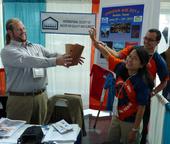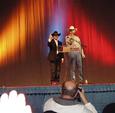Highlight
IGERT Trainees Actively Participate in and Plan Major Conferences
Achievement/Results
Trainees of the National Science Foundation’s (NSF) Integrative Graduate Education and Research Traineeship (IGERT) program in Indoor Environmental Science and Engineering at The University of Texas (UT) learn from active participation in technical conferences. Through the University of Texas’ commitment to the program, trainees and affiliates continue to receive travel stipends to present their results at technical conferences. Participation in conferences is one of the pillars of the program’s professional development efforts, and has benefited IGERT trainees and affiliates as public speakers and the professional connections made at such conferences. It has also benefited the program, as our trainees and affiliates are great ambassadors.
During the past year, 18 of our IGERT students (11 trainees and 7 affiliates) attended nine different conferences and delivered 21 presentations (nearly all at podium). Fifteen of our trainees and affiliates traveled to Syracuse, New York, to participate in Healthy Buildings 2009, a major international conference attended by representatives of 45 countries. With 21 total attendees (15 students, 5 faculty members, 1 staff member), our IGERT program was the seventh largest “country” in attendance. Our students garnered great praise for their intellectual contributions.
In 2011, the largest international conference on indoor air quality (Indoor Air 2011) will be held in Austin and organized by the University of Texas at Austin. This triennial conference, last held in Beijing in 2005 and Copenhagen in 2008, is expected to draw 1,500 attendees from 50 different countries. Trainees and affiliates of the IGERT program on Indoor Environmental Science and Engineering at UT will play a prominent role at the conference. Fifteen IGERT students have formed a student program committee and have begun developing a detailed program for the expected 300 to 400 graduate students who will attend from around the world. In addition to social activities, e.g., a student dinner on the first evening, the student program will include graduate students teamed with prominent researchers as co-chairs for conference technical sessions, coordination of a student video competition, and career roundtables with researchers from industry, government, and academia. An important part of the student program will be a symposium designed and implemented by students. The students have been given three session/workshop time slots (approximately eight hours) covering the first three days of the conference and have been given control over session/workshop topics, speakers, and general design. In addition to planning these activities, IGERT students are also helping to develop a social network to reach graduate students from around the world before the conference, to keep them abreast of their activities, and to encourage participation in the conference.
Address Goals
These activities involve substantial learning. When students present their research findings at conferences they practice their presentations at formal group practice sessions in front of peers and faculty members who provide feedback, thus allowing them to learn how to deliver effective technical presentations. The primary discovery component of these activities preceded presentation delivery and was in the form of one or more research discoveries that are presented at conferences. Importantly, students often receive feedback on their research at conferences that helps them to think of their findings in different ways, possibly leading to additional discovery. Finally, in helping to plan Indoor Air 2011, IGERT trainees and affiliates are learning how to organize a major technical conference in their field, and must take into account the nuances of international participation.







